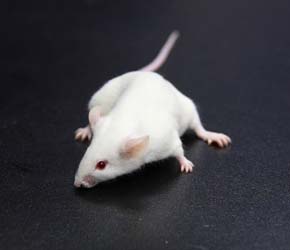Compound used by TV crime detectives helps detect immune inflammation in mice
 London, March 23: A compound used by TV show detectives to make blood glow, known as luminol, is now being used by scientists to highlight the sites where the immune system attacks the body’s own tissues.
London, March 23: A compound used by TV show detectives to make blood glow, known as luminol, is now being used by scientists to highlight the sites where the immune system attacks the body’s own tissues.
Researchers at Washington University School of Medicine in St. Louis have found that injected luminol glows blue at sites of active immune inflammation in living mice.
The researchers say that this glow can be detected from outside the mice with the aid of scientific cameras.
Immune inflammation is thought to be a critical component of arthritis and other autoimmune diseases, atherosclerosis, some forms of cancer and neurodegenerative disease.
The researchers say that being able to image such inflammation from outside the body may help better understand and control it.
"It''s quite striking how specific and sensitive this approach is. For example, we have evidence that this technique can highlight inflamed tissue that is on the way to becoming cancerous but not yet discernible via visual or tactile inspection," Nature magazine quoted senior author Dr. David Piwnica-Worms, professor of radiology and of developmental biology, as saying.
He says that cardiologists these days believe that immune inflammation is a key component that makes an arterial plaque dangerous.
According to him, such inflammation causes platelets to bind to plaques, leading the plaques to rupture or break away and putting the patient at risk of heart attack, stroke or lung clots.
Given that blood vessels of the chest and torso are very deep within the body, the researcher says that it is difficult to image them with this approach.
However, he adds, because vessels of the leg and neck are close enough to the skin, the technique may be "directly translatable" to use in human patients.
Postdoctoral fellow Dr. Shimon Gross, the lead author of the study, proposed that luminol might be used to image inflammation when he found earlier studies linking luminol bioluminescence with myloperoxidase (MPO), a protein some types of immune cells use to make bleach during the inflammatory process.
When a mixture of hydrogen peroxide and luminol is used onto crime scenes, it reacts with iron from blood, causing the luminol to glow.
In the living body, though, iron isn''t as accessible. The iron in hemoglobin is still inside red blood cells, and is often bound to oxygen, blocking the reaction with luminol.
During the study, Gross and Piwnica-Worms injected luminol into mice anticipating that they would need a way to distinguish immune inflammation from other processes that might also cause the luminol to luminesce.
The researchers instead found that the compound only glowed at sites of immune inflammation involving MPO.
"Everything''s kept compartmentalized when it''s still in the body. When it comes to making luminol glow, the only places where all the necessary ingredients come together in concentrated form in the living body are in active phagocytes containing MPO," says Piwnica-Worms.
Upon dabbing an irritant onto the ears of normal mice and injecting luminol, the researchers observed that immune cells that migrated to the irritation site glowed.
However, no glow could be detected in mice lacking the MPO gene.
With a view to further testing the technique, Dr. Lee Ratner injected luminol into the mice that had a type of tumour known to be rife with active immune cells.
It also highlighted areas of inflammation that weeks later would become tumours, said the researcher.
The scientists also used the technique to show inflammation in a mouse model of acute arthritis.
Piwnica-Worms says that the observations made during the study suggest that luminol’s use may improve arthritis patient management, and enable rapid assessment of the effectiveness of new treatments.
He and his colleagues are currently working to modify luminol chemically to improve its clinical potential.
A research article on this study has been published in the journal Nature Medicine. (ANI)